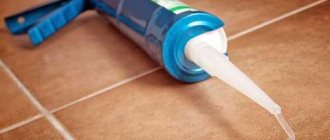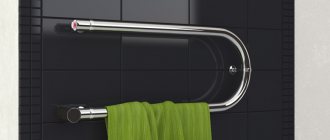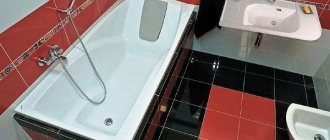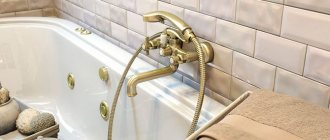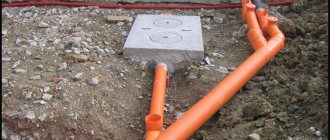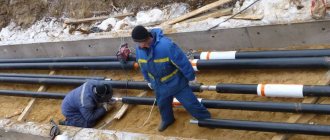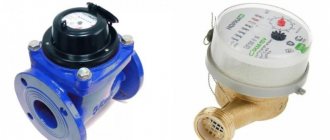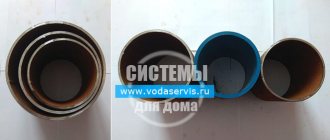The equipment of most bathrooms in apartment buildings and individual residential buildings includes a specially shaped heat exchanger that performs the functions of a heated towel rail. The bathroom coil can have different designs; it is connected to the hot water supply line in order to maintain the device in a constantly heated state.
The coil models on the market differ from each other not only in design, but also in the methods of heating the heat exchange device. When placing a device with your own hands in the bathroom, you will need knowledge about the models produced, the materials used to make them, and installation features.
U-shaped and M-shaped coils
Functions and purpose
Although the coil heated towel rail appeared on the market relatively recently, in a short period of time it gained great popularity and became an indispensable attribute of the bathroom. The device provides special comfort and coziness, which is explained by its ability to maintain a stable temperature regime, as well as dry wet towels and linen.
In Soviet buildings, snake-shaped dryers are very common, and in more modern ones, modernized forms are already appearing - stairs, drops and others. The main purpose of the coil is to heat the bathroom, which prevents the spread of humidity, and a comfortable microclimate in the room minimizes the risk of mold.
The key functions of the heated towel rail are as follows:
- Heating the bathroom and providing a comfortable microclimate. The operation of the device warms up the space of this part of the apartment well, making bathing safe even for small children.
- Fighting mold. As you know, there is always high humidity in the bathroom, which turns into condensation and settles en masse on the walls. If you do not remove it from the room in time, this will lead to deformation of the finish and the development of infections. Therefore, a stable temperature is the most important attribute of a comfortable stay in the house, as well as the best protection against dampness and mold.
- Drying towels and linen.
Built-in ventilation systems are unable to cope with this volume of work, so purchasing a coil is a very important decision.
Purpose of a bathroom coil
A wall-mounted bathroom dryer designed in the form of a coil performs several functions:
- Dries towels, washed linen, wet clothes, shoes, acting as a battery.
- It warms the room, maintaining constant heat and increasing the comfort of its use after taking water procedures in the bath or shower. When going out into the open air, a wet body will not experience discomfort when it comes into contact with too cold air.
- Dries moisture, leveling the steam effect and protecting the room from the formation of fungus and mold, preventing corrosion of metal parts of plumbing fixtures, household appliances, elements of sockets, switches and lighting.
Double-circuit heated towel rails
Main types
Currently, various types of coils are offered in hardware stores. Among the most popular are:
- Water.
- Electric.
- Combined.
The last option combines the functions of the previous two, which makes it especially popular. But combined coils are not cheap.
Before deciding on a specific heated towel rail model, you need to make sure that it meets some requirements. It is also important to pay attention to a number of other points:
- When operating the device, the operating pressure must correspond to the pressure in the system. Any surges and deviations from the required norm can lead to damage to important components or the coil as a whole.
- It is also recommended to study the table that comes with the device and calculate the standard thermal power.
A Question of Choice
Photo of an electric coil in the bathroom
Coils are essentially heated towel rails. This name is explained simply - by the shape of the product, which resembles a writhing snake.
One way or another, before installing this device in a plumbing unit, you should first decide which type of coil is best for you. There are three options:
Now let's look at each of them in more detail.
Mermen
This is the simplest solution in terms of device design. Plus, connecting it is not difficult, since all standard apartments have a heated towel rail. However, from the point of view of efficiency and practicality, a water coil cannot be called optimal. The work of the housing office and constant shutdowns of centralized hot heating will turn the device for drying towels into an ordinary metal hanger.
It’s another matter if you have autonomous, individual heating, from which heated water will flow into the coil system, thereby activating its main functions. But here lies another problem - the likelihood of scale formation is high. The quality of the water in the tap is far from ideal, and scale will lead to the need to change the entire coil.
Electrical
Such devices are a kind of conventional electric heater, which contains oil inside.
Many people believe that a mains-powered dryer will consume a lot of electricity. In fact, this is a misconception, since the level of electricity consumption of a coil can be compared to a low-power light bulb.
As a result, we are dealing with an effective, fairly economical device that can heat a room without particularly affecting the final electricity bills.
With such a device, you should be careful when connecting it, strictly following the instructions. Another advantage is the ability to turn the coil on and off when you need it. Some models are equipped with timers, thermostats and other additional elements.
Combined
However, given the fact that combined devices can be switched on from two heat sources, choosing which one is most profitable, then the cost should be considered justified.
Water models
The most popular types of coils are water appliances. They represent a kind of “classics of the genre”, which were used in the distant past. Every old house is equipped with such a device.
The device is connected to the central system and can only work in cold weather, when the heating season begins. Hot water circulates inside the structure, which warms up the room.
But with an autonomous heating system, the water device will function all year round. Any changes or shutdowns are impossible, since the owner of the premises himself determines when to turn on the heating and when to turn it off.
The disadvantage of a water heated towel rail is the risk of air pockets or sediment on the walls. Fortunately, troubles can be solved by simply cleaning the pipes.
If the water quality is too low, it will not be possible to avoid scale formation inside the mechanism. This phenomenon can cause damage to the coil.
Why domestic heated towel rails are more reliable than imported ones
Imported equipment is most often designed to be connected to a heating system. In addition to being inconvenient, the quality of water in our heating networks leaves much to be desired, so pipes and dryer seals fail very quickly.
One more detail - the thread diameter in domestic devices almost always coincides with the connecting nodes on the pipeline. On imported coils these parameters may not be the same. But this is not the most important thing.
The pressure in the hot water system depends on the condition of the pipeline, the initial pressure in the boiler room and even the number of floors. According to standards, the pressure at the entrance to plumbing equipment should not exceed 4.5 atmospheres, but in practice this value can be much higher, especially on the lower floors.
The design pressure for coils is 6 atm. in operating mode and 10 atm. during overloads. In practice, it is advisable to choose values an order of magnitude higher; this will provide some guarantee against a gust during a strong pressure surge.
Important! Domestic heated towel rails are designed for large pressure surges. Imported structures may not withstand peak overloads.
Electrical devices
Electric models are a good alternative to classic water-based coils. The main advantage of this type of dryer is its autonomy, because the user can turn it on at any convenient time. The operation of the device is based on a heating element, oil or water, which is heated by electricity. And if water devices are installed only near a direct connection with the heating system, then electric ones are not tied to this factor and can be placed anywhere, provided that there is an outlet there.
As for energy consumption, according to experts, it remains virtually unchanged. The monthly operation of the coil is comparable to the operation of a conventional 100 W light bulb.
However, when purchasing an electrical device, you need to take into account its power consumption and the presence of a regulator that controls the ambient temperature. In terms of safety, there are no comments regarding the electrical device. It is reliably protected from contact with water and is safe for use in wet environments.
Functionality. Application
Coil
The relevance and prevalence of the coil has increased quite recently and has rapidly captured the domestic market of plumbing fixtures. The remarkable efficiency of the heating element is justified by its compactness and heating efficiency. Bulky, heavy radiators are extremely impractical in a small bathroom. The following functional features of the coils ensure the popularity of the device.
The relevance of coils is justified by the increased humidity, which, in turn, provokes the development of mold. Modern lines of snake-like dryers have acquired new forms: ladder, drop.
Material of manufacture
The operating principle of the above types of coils is almost the same. The only differences are the heating method or the material used.
Modern manufacturers use the following materials:
- Stainless steel. It is considered the most practical, but is afraid of interaction with aggressive impurities in water. Stainless steel coils are often coated with chrome, polish or waterproof paint. The most durable and reliable are chrome-plated models. Painted products are also in great demand, but their service life is much lower than the previous ones, and the paint wears off quickly.
- Black steel with protective coating. The inner walls of this material are treated with an anti-corrosion compound. From the outside, the device is not much different from stainless steel models.
- Non-ferrous metals. In most cases, brass and copper are used here, which have good heat transfer but a short service life. Such devices are famous for their aesthetic appeal, but not for their practicality.
When purchasing a stainless steel coil, you need to make sure that it is really high-quality material. The fact is that recently a lot of fakes have appeared on the market that look exactly like good stainless steel, but are actually just a marketing ploy. To avoid a rash choice, you must ask the store for documents and a guarantee.
Shapes of heated towel rails
Unusual design forms of heated towel rails
Choosing heated towel rails for the bathroom only based on the principle of operation is obviously the wrong position; you need to decide on the shape of the structure, volume and take into account the dimensions. And for this you need to have all the information. Absolutely all bathroom heated towel rails can be divided into groups:
Heated towel rail in the bathroom. Choosing between electric and water solutions
- M-shaped. Simple, ordinary dryers that are found in every home. This shape is ideal for heating a room and also plays the role of a compensation loop. A clear advantage of the model is the price. When you find out how much a bathroom coil costs, make sure that this form is the most affordable. The downside is a small selection of designs. This type of drying is suitable for users who prefer simplicity, reliability and comfort.
Advice! When choosing a rotary heated towel rail, look at the connection system (distance between pipes). The fact is that all models are produced according to the same standard and any deviation to the side is not allowed.
- U-shaped heated towel rail. This is a more attractive model that will perfectly complement the bathroom interior. Manufacturers offer a wide range of products, which will allow you to choose the desired shape. The cost of a U-shaped heated towel rail for a bathroom is slightly higher, but this is justified by the design variety of designs.
Important! This model is a non-rotating model and is connected in the case of water heating only with a side connection
Non-standard models for stylish interiors
- The ladder is a very beautiful heated towel rail. The shape is similar to a regular staircase (vertical pillars and horizontal lintels), and the pipes themselves can be either straight or curved in any direction. The price depends on the complexity of the shape, the number of horizontal sections and vertical guides.
- A corner heated towel rail is an ideal solution for small spaces. Installing the model in a corner is extremely simple, and the design takes up so little space that this particular dryer is often used in large bathrooms: several pieces mounted in the corners provide a comfortable temperature throughout the room. Despite its simplicity, the dryer is quite spacious and is often designed in the form of a ladder, with a different number of sections;
- A heated towel rail with a shelf is a beautiful and practical accessory. Most often it is of the water type and is recommended for installation in large rooms. The shelf is useful for drying gloves and shoes. The assortment is varied and offers a choice of models of very different lengths and widths;
- A floor-mounted heated towel rail is another model that will fit well in a small bathroom. The connection is made depending on the type of structure; the advantage is the large capacity and the ability to heat any area;
- Coil – This heated towel rail is the most popular model. When choosing which coil is best for the bathroom, proceed from the area of the room. Too long is recommended for large bathrooms, but for small shapes a coil of one or two turns is suitable. The design is rotatable, which makes its use as convenient as possible.
To see all the variety of shapes and understand how to dry towels in the bathroom on the most fancy dryers, look at the photos presented in the article. It is likely that in the photograph you will be able to find exactly what you need for your bathroom.
Tips for a successful purchase
Making the right decision when buying a coil can be difficult, which is explained by the wide variety of devices sold . To make the right choice, you need to consider the following criteria:
- Is there stable access to hot water or electricity in the room?
- What material is the device made of? It is necessary to choose only those models that are not afraid of corrosive effects or contact with aggressive additives in water.
- What are the dimensions of the coil? You should calculate the ratio of pipe diameters in advance - it must correspond to the size of the water pipe if we are talking about installing a water heated towel rail.
- Does the device fit into the overall concept of the bathroom style? A wide range of different designs of coils are available on the market, so choosing a beautiful option that will complement the uniqueness of the interior will not be difficult.
- Is a technical passport provided with the heated towel rail?
After studying these criteria, you can begin to look for a suitable coil model. Regardless of its shape or operating principle, the device will be a useful addition to the bathroom, allowing you to maintain a comfortable temperature at any time of the year and prevent the appearance of mold and other problems.
Combined coil designs
Such a universal device has absorbed all the positive characteristics of both water and electric coils. However, despite the functionality of such a product and the possibility of its use regardless of central heating, it has a rather high cost. Although such costs are justified, since there is no need to be afraid of interruptions in the supply of electricity or heat supply - in the absence of one of the coolants, there is always another heat source available.
Installation features
Even at the stage of purchasing a coil, it is necessary to consult with specialists or professional plumbers to consider the best connection options. In this case, the selection of components will be faster and more productive.
When planning to purchase a water coil-towel rail, you should clarify what materials its radiator and pipes are made of. If they are made of different materials, a dielectric plate will need to be placed between them, which will prevent the possible occurrence of stray currents from interaction with metal surfaces.
When it comes to electric bathroom coils, they are much easier to install than water coils. However, installation work may be accompanied by some difficulties that cannot be ignored.
It is important to design the future connection first to avoid troubles in the future. It is also necessary to take care of the hidden installation of sockets, hiding them directly in the wall.
When choosing an electrical device, it is advisable to give preference to those models that are equipped with a tight-fitting lid that prevents splashes. Also, electrical appliances need a protective shutdown system that can protect them from short circuits when the outlet is de-energized. The electric coil is connected to the general power network using a thick cord with careful insulation.
You should begin replacing or installing a coil in the bathroom only after choosing a promising location. In this case, the installation work can actually be completed with your own efforts, and its duration will be no more than an hour and a half.
If installation involves a complete rework of the hot water supply riser, you cannot do without professional help. Such actions may be required in cases where there was previously a curved pipe in the place of the current coil.
To successfully replace the hot water riser, you will have to install shut-off ball valves and a bypass ring. With their help, it will be possible to turn off the device in the event of a possible leak without calling a specialist. Unfortunately, this type of work requires a lot of effort and can take all day.
The following tools are used during the replacement process:
- Electric drill and level.
- Screwdriver and screwdriver.
- Keys, couplings, corners.
Design features of modern coils
Modern heated towel rails have long evolved from a standard painted coil into an original design object. Such products have become so widely popular that when developing their appearance, famous designers are involved, who create original products, which are later replicated and put on store shelves. Such an original device not only copes with its direct responsibilities, but also decorates any bathroom.
On the plumbing equipment market, every homeowner will be able to choose a suitable product in a color that matches the overall design of the bathroom. This will complement the overall styling of the interior, making it complete and organic. By choosing products in bright colors, you can play on the contrast of the bathroom, emphasizing its individuality. If bright shades do not attract the homeowner, then you can always choose a chrome-plated product that will succinctly fit into a room designed in a minimalist or high-tech style.
Installation steps
If the task is to replace an old device, then first you need to remove it, which is done very simply. The first step is to turn off the water and unscrew all the fastening nuts through which the device is connected to the water pipes. Then you should carefully remove the fasteners and device from the wall.
Once the dismantling work is completed, you can remove the new device from the box and begin installation. Holders are attached to the new model and connections are screwed through which water will be supplied. Next, the structure is placed against the wall, and the necessary marks are made with a pencil.
The next step is to drill all the holes in the tiles and insert dowels into them. It is better to use plastic products as fasteners. After making sure that the device is located correctly, all that remains is to fix it on the wall and connect it to the general piping system or central heating.
It is important to note that many bathroom coil manufacturers, as well as their distributors or retail outlets, offer a range of installation services. In this case, the task is performed by a specialist, and the consumer is provided with a full guarantee for installation work. When purchasing a new device, it is better to take advantage of this opportunity, as this will avoid many troubles in the future. But if independent installation does not seem incredibly difficult, then it is quite possible to implement it on your own.
Finally about combined dryers
A double-circuit heated towel rail perfectly solves the problem of seasonality when connecting to home heating. During the cold season, the water circuit is heated; at the end of the heating season, you can turn on the second electric coil. The mounting of the device is quite ordinary - on brackets, the connection is made immediately to 2 networks - electrical and heating.
If it is necessary to change the old Soviet coil in an apartment, then the new one does not have to be installed in the same place and connected to the existing fittings. It is very advisable to replace the riser - it is probably “overgrown” with rust. Choose a suitable location for the heater, sketch out the connection diagram and install the heated towel rail according to the new requirements.
Causes of leaks
The third drawback is leaks. According to statistics, it is these water dryers in the bathroom that are the most common cause of flooding for neighbors below.
Why does this happen and how can it be avoided? When installing water heated towel rails, the human factor plays the most important role. Not its novelty and quality, but precisely the installation moments and the level of the installer.
Somewhere, not enough sealing material was added to the threads or the gasket was skewed. Somewhere a nut was not tightened. All this eventually leads to a small leak.
Moreover, the joints are usually masked and covered with false walls, or recessed into them. As a result, you won’t even notice this leak.
Water will gradually accumulate behind the tiles and at one point all this beauty will simply fall off the wall.
Here's a scary video of what really happens to the neighbors below when a pipe breaks on a water heated towel rail under pressure of several atmospheres.
Saving on cheap fittings and craftsmen ends up costing millions in months of repairs. After this, people immediately switch to electric alternatives.
And if your installation was done by a truly professional and the product itself is branded, can you be 100% sure that there will be no leaks and you won’t flood anyone? No again!
This is where the fourth factor comes into play - the quality of hot water. If it is too “aggressive” and contains a large number of chemically active components, then in a year or two, such a liquid will corrode the thin walls at the threaded connections.
Only daily monitoring, inlet filtration and timely purchase of new spare parts or the entire dryer will help here.
